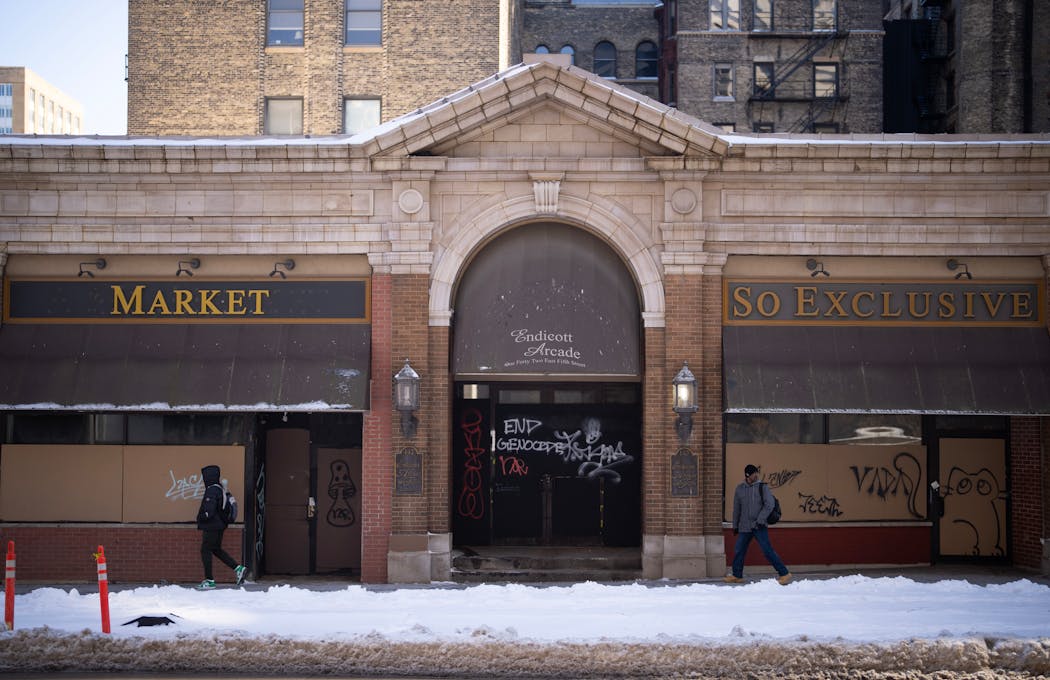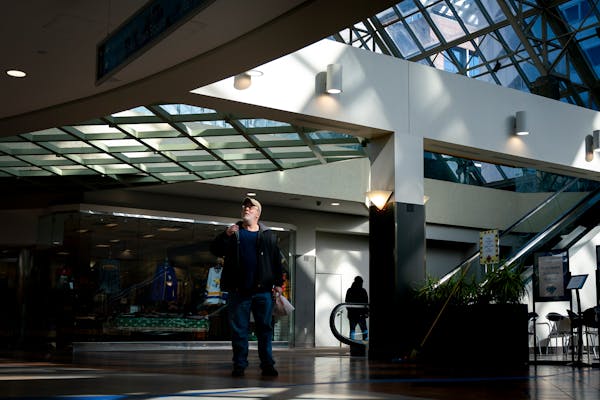It takes 20 minutes to walk from the Xcel Energy Center to CHS Field on St. Paul's 5th Street, a route dotted with other beloved downtown destinations — the Ordway and Landmark Center, Rice and Mears parks, the St. Paul Farmers' Market.
Pedestrians on that sidewalk also pass the Central Station light rail stop, where the entrance to the skyways has been padlocked for more than a year after a double homicide there. They encounter the boarded-up storefronts of the Endicott Arcade, a century-old galleria that in 2021 was deemed unfit for occupancy. They stride by Momento, a Mediterranean restaurant that opened and closed in the last two years.
A trip down 5th Street spotlights many of the struggles downtowns have experienced across the country even before the shock of the COVID-19 pandemic: vacant office buildings, shuttered storefronts, declining property values, sidewalks populated by the homeless.
But to St. Paul leaders, that walk also is ripe for envisioning a more vibrant downtown — and strategizing how to manifest it.
Offices could be converted to apartments with the help of state and city incentives. A street reconstruction could make it safer and better for pedestrians. Multimillion-dollar redevelopments of the Xcel Center and Central Station could bring new life to key parts of the neighborhood.
"If we don't do anything, there's a real risk for downtown to follow a path of disinvestment and a kind of downward spiral — and the consequences of that are not just dire for those of us who love it here or who live here or work here," said Joe Spencer, president of the nonprofit St. Paul Downtown Alliance, which recently published a 117-page report recommending public and private investments in downtown.
At the crux of its strategy is the belief that drawing more residents, workers and visitors downtown will solve many of the problems. The civic and business leaders involved with the plan's creation don't know how much it will cost, but it's clear substantial government funding is expected as a catalyst.
"I think it's a moment of reckoning for downtown," said Richard Dobransky, president of Morrissey Hospitality, a portfolio that includes Roy Wilkins Auditorium, the St. Paul Hotel and the recently closed Momento. "Because if we don't do something, then nothing's going to happen, so it will continue on the path of being worse."
An entertaining gateway
Built in the 1870s, 5th Street was part of the retail district in downtown St. Paul's mid-20th century heyday. While not the main shopping corridor, the Gokeys and Frank Murphy clothing stores were among the once well-known businesses with a 5th Street address.
These days, those entering downtown on the west side of 5th Street are greeted by downtown's busiest hub, the Xcel Energy Center. Opened 24 years ago, the hockey arena draws 3 million visitors annually. Now city leaders and the Minnesota Wild want the Legislature to pay several hundred million dollars to renovate the arena, to anchor an expanded entertainment district that includes housing, retail and an outdoor festival plaza.
Before and after hockey games or concerts, crowds flood 5th Street, past the glow of Rice Park, ornate Landmark Center and the historic St. Paul Hotel, which has hosted multiple U.S. presidents. But on the nights when the arena was empty, so were the tables at Momento. Now the space will be used to host events and occasional pop-ups, Dobransky said.
The Starbucks and Chipotle on the same block cater mainly to office workers and high school students attending the skyway-level St. Paul Conservatory for Performing Artists. Patrick Nathan, manager of neighboring SubText Bookstore, said he'll sometimes get off the bus in Lowertown before weekend shifts since there's nowhere closer to get coffee.
The subsequent walk up 5th Street "isn't exactly pleasant," he said.
"It's actually kind of New York in the sense that there's a lot of fun stuff to do uptown, a lot of fun stuff to do downtown," he said. "But in the middle there's this big mess no one wants to walk through. Basically from the train station, the Central stop, for another three or four blocks it's just this open concrete nothingness."
The dead zone
A handful of ideas for how to activate that so-called "experiential hole" emerged during the strategic planning process, which was led by New York-based consultant James Lima Planning, Development.
The city is planning to dedicate close to $1 million of its new sales tax revenue next year to spruce up the Osborn Plaza at the corner of 5th and Wabasha with landscaping, public art and seating.
Spencer hopes that 5th Street might be up for total reconstruction in coming years, with a goal of narrower streets, wider sidewalks, trees and planters. The report suggests closing unused parts of the skyway system to encourage retailers to move to the street, but the concept was not explored in depth.
Downtown leaders, residents, workers and visitors have all said improving Central Station should be a top priority. Gun violence, drug dealing and drug use have made the light rail stop notorious.
Metro Transit and the city this week launched their formal search for development proposals for the 1.66-acre lot, with the offer of potential financial assistance.
"There aren't very many sites that are in the middle of a major downtown that are as completely open as this one and on, or potentially on top of, a train," said City Council Member Rebecca Noecker, who represents the area.
Indianapolis-based Flaherty & Collins Properties has expressed interest in the site to build dense housing over ground-floor public space and retail.
A blank canvas
The latter could be a boon to that stretch of 5th, which has little activity at the street level, despite boasting entrances to some of the most recognizable buildings in St. Paul's skyline.
A block beyond Central Station sits the First National Bank Building, which saw its estimated market value dropped by nearly 10%, or $3.2 million, between 2021 and 2024. A bit farther down 5th sits the dilapidated Endicott Arcade. It was designed by Cass Gilbert, the architect responsible for the Minnesota State Capitol, the U.S. Supreme Court building and New York's Woolworth Building.
Both properties belonged to downtown St. Paul's largest property owner, Jim Crockarell, who died in January. What happens to Crockarell's Madison Equities portfolio could have big implications for downtown and 5th Street, Spencer said.
Downtown leaders also are preparing for the state to vacate offices downtown as a handful of agency leases expire in the coming years. Spencer said state government workers have returned to work in far fewer numbers compared to city and county employees.
"I'd rather have one of those buildings convert to residential than sit empty," he said. "Not to be cavalier about the lease payments that they're making … but what we want are full, vibrant buildings, where people are coming in."
Some still are perplexed at the Downtown Alliance report's declaration that 5th Street should be downtown's "busiest pedestrian thoroughfare."
"It just doesn't seem like it is exceptional in any particular way," said Bill Hanley, who lives in a condo by Mears Park. Less than a decade ago, Hanley remembers, there was a push to transform 4th Street into the vibrant east-west connector.
That idea never came to fruition, a similar fate to any number of downtown visions. Spencer thinks it's partly because 4th Street recently had been reconstructed for light rail. By contrast, he said, 5th Street is more of a blank canvas.

Gun safety bills may hinge on one senator's fate despite House support, likely passage

At the U, another pro-Palestinian protest camp goes up

Falcon Heights, St. Anthony nearing police partnership severed after Philando Castile's killing

Supporters rally at courthouse as state trooper appears for hearing in shooting





